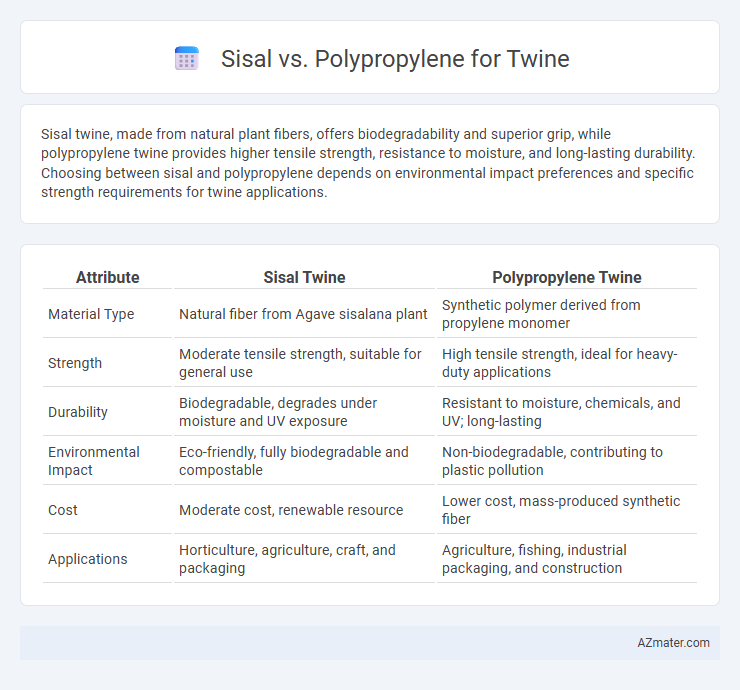Sisal twine, made from natural plant fibers, offers biodegradability and superior grip, while polypropylene twine provides higher tensile strength, resistance to moisture, and long-lasting durability. Choosing between sisal and polypropylene depends on environmental impact preferences and specific strength requirements for twine applications.
Table of Comparison
| Attribute | Sisal Twine | Polypropylene Twine |
|---|---|---|
| Material Type | Natural fiber from Agave sisalana plant | Synthetic polymer derived from propylene monomer |
| Strength | Moderate tensile strength, suitable for general use | High tensile strength, ideal for heavy-duty applications |
| Durability | Biodegradable, degrades under moisture and UV exposure | Resistant to moisture, chemicals, and UV; long-lasting |
| Environmental Impact | Eco-friendly, fully biodegradable and compostable | Non-biodegradable, contributing to plastic pollution |
| Cost | Moderate cost, renewable resource | Lower cost, mass-produced synthetic fiber |
| Applications | Horticulture, agriculture, craft, and packaging | Agriculture, fishing, industrial packaging, and construction |
Introduction to Twine Materials
Sisal and polypropylene are two common materials used for twine, each with distinct properties suited for different applications. Sisal, derived from the Agave plant fibers, offers natural biodegradability, strength, and resistance to UV light, making it ideal for agricultural and gardening uses. Polypropylene twine features synthetic durability, water resistance, and cost-effectiveness, frequently employed in packaging, baling, and marine environments.
What is Sisal Twine?
Sisal twine is a natural fiber made from the leaves of the Agave sisalana plant, known for its strength, durability, and eco-friendly properties. It is biodegradable and widely used in gardening, agriculture, and crafts due to its resistance to moisture and rough handling. Compared to polypropylene twine, sisal offers a sustainable alternative with lower environmental impact but may have a shorter lifespan in wet conditions.
What is Polypropylene Twine?
Polypropylene twine is a synthetic fiber made from polymerized propylene, known for its high tensile strength, resistance to moisture, and durability. It is lightweight, chemical-resistant, and commonly used in agricultural, packaging, and industrial applications where weather resistance and longevity are crucial. Compared to natural fibers like sisal, polypropylene twine offers enhanced resilience against rot, mildew, and UV degradation.
Strength and Durability Comparison
Sisal twine offers natural fiber strength with moderate durability, making it suitable for tasks requiring biodegradability and moderate tensile resistance. Polypropylene twine surpasses sisal in tensile strength and durability, resisting moisture, UV damage, and chemical exposure, which extends its lifespan in harsh conditions. For heavy-duty applications demanding long-term resilience, polypropylene is the preferred choice due to its superior strength retention and weather resistance.
Weather Resistance: Sisal vs Polypropylene
Polypropylene twine offers superior weather resistance compared to sisal, as it is highly resistant to moisture, UV rays, and chemicals, ensuring durability in outdoor conditions. Sisal twine, made from natural fibers, tends to degrade, weaken, and rot when exposed to prolonged moisture and harsh weather. For applications requiring extended exposure to rain, sun, and humidity, polypropylene provides a longer-lasting and more reliable solution than sisal.
Environmental Impact and Biodegradability
Sisal twine, derived from natural Agave fibers, offers superior biodegradability and decomposes quickly in soil, reducing environmental pollution. Polypropylene twine, made from petroleum-based polymers, resists degradation and can persist in ecosystems for decades, contributing to microplastic pollution. Choosing sisal over polypropylene supports sustainable agriculture and minimizes plastic waste accumulation.
Cost Effectiveness and Availability
Sisal twine is generally more expensive than polypropylene due to its natural fiber sourcing and labor-intensive production, but it offers superior biodegradability and strength. Polypropylene twine is highly cost-effective, widely available in various thicknesses, and offers resistance to moisture and chemicals, making it a popular choice for industrial applications. Availability of polypropylene twine is more consistent globally due to synthetic manufacturing processes, whereas sisal supply can be limited by agricultural and climatic conditions.
Common Uses of Sisal Twine
Sisal twine, derived from natural agave fibers, is commonly used in gardening, agriculture, and crafting due to its biodegradability and strong tensile strength. It is ideal for tying plants, wrapping bundles, and creating decorative crafts, offering an eco-friendly alternative to synthetic options like polypropylene twine. Polypropylene twine, while more resistant to moisture and chemicals, lacks the natural biodegradability that makes sisal preferred for environmentally conscious applications.
Common Applications for Polypropylene Twine
Polypropylene twine is widely used in agriculture for baling hay and straw due to its high tensile strength and resistance to moisture and UV degradation. Its lightweight and cost-effective properties make it ideal for packaging, shipping, and securing loads in various industrial applications. Additionally, polypropylene twine is popular in gardening and construction for tying plants and bundling materials, offering durability and weather resistance where natural fibers like sisal may deteriorate.
Choosing the Right Twine for Your Needs
Sisal twine offers natural biodegradability and strong abrasion resistance, making it ideal for gardening, crafting, and eco-friendly applications. Polypropylene twine excels in durability, water resistance, and high tensile strength, perfect for heavy-duty tasks like packaging and agricultural use. Selecting the right twine depends on intended use, environmental concerns, and strength requirements to ensure optimal performance and sustainability.

Infographic: Sisal vs Polypropylene for Twine
 azmater.com
azmater.com